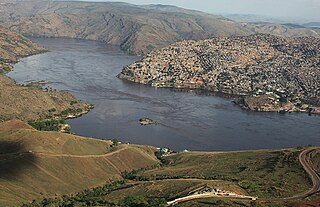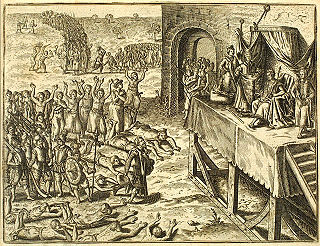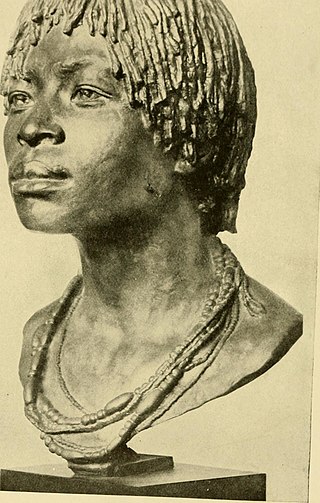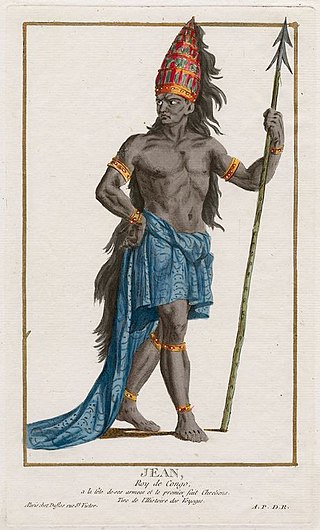Related Research Articles

Matadi is the chief sea port of the Democratic Republic of the Congo and the capital of the Kongo Central province, adjacent to the border with Angola. It had a population of 245,862 (2004). Matadi is situated on the left bank of the Congo River, 148 km (92 mi) from the mouth and 8 km (5.0 mi) below the last navigable point before the rapids that make the river impassable for a long stretch upriver.

The Manikongo, or Mwene Kongo, was the title of the ruler of the Kingdom of Kongo, a kingdom that existed from the 14th to the 19th centuries and consisted of land in present-day Angola, Gabon, the Republic of the Congo and the Democratic Republic of the Congo. The manikongo's seat of power was Mbanza Kongo, now the capital of Zaire Province in Angola. The manikongo appointed governors for the provinces of the Kingdom and received tribute from neighbouring subjects.

The Kongo people are a Bantu ethnic group primarily defined as the speakers of Kikongo. Subgroups include the Beembe, Bwende, Vili, Sundi, Yombe, Dondo, Lari, and others.
The Kingdom of Ndongo, 1515-1909, was an early-modern African state located in the highlands between the Lukala and Kwanza Rivers, in what is now Angola.

The Kingdom of Loango was a pre-colonial African state, during approximately the 16th to 19th centuries in what is now the western part of the Republic of the Congo, Southern Gabon and Cabinda. Situated to the north of the more powerful Kingdom of Kongo, at its height in the 17th century Loango influence extended from Cape St Catherine in the north to almost the mouth of the Congo River.

Álvaro I Nimi a Lukeni lua Mvemba was a Manikongo, or king of Kongo, from 1568 to 1587, and the founder of the Kwilu dynasty.

The Kingdom of Kongo was a kingdom in Central Africa. It was located in present-day northern Angola, the western portion of the Democratic Republic of the Congo, and the Republic of the Congo. At its greatest extent it reached from the Atlantic Ocean in the west to the Kwango River in the east, and from the Congo River in the north to the Kwanza River in the south. The kingdom consisted of several core provinces ruled by the Manikongo, the Portuguese version of the Kongo title Mwene Kongo, meaning "lord or ruler of the Kongo kingdom", but its sphere of influence extended to neighboring kingdoms, such as Ngoyo, Kakongo, Loango, Ndongo, and Matamba, the latter two located in what is Angola today.
Nsundi was a province of the old Kingdom of Kongo. Its capital was located on the Inkisi River, near the present-day village of Mbanza Nsundi in Democratic Republic of Congo.

The Kinlaza were members of the Nlaza kanda or House of Kinlaza, one of the ruling houses of the Kingdom of Kongo during the 17th century. It was one of the main factions during the Kongo Civil War along with the Kimpanzu and Kinkanga a Mvika kandas. They are remembered in tradition and are evoked in a proverb, still current in the 1920s Nkutama a mvila za makanda "Kinkanga, Kimpanzu ye Kinlaza makukwa matatu malambila Kongo".

Lukeni lua Nimi was the traditional founder of the Lukeni kanda dynasty, first king of Kongo and founder of the Kingdom of Kongo Dia Ntotila. The name Nimi a Lukeni appeared in later oral traditions and some modern historians, notably Jean Cuvelier, popularized it. He conquered the kingdom of Mwene.

Nzinga-a-Nkuwu João I was the 5th ManiKongo of the Kingdom of Kongo between 1470 and 1509. He voluntarily converted to Roman Catholicism. He was baptized on 3 May 1491 and took the Christian name of João. Soon after, ManiKongo Nzinga-a-Nkuwu João I abandoned the new faith for a number of reasons, one of them being the Roman Catholic Church's requirement of monogamy. Politically, he could not afford to abandon polygamy and embrace monogamy, a cultural shift that the king could not contemplate as power in Kongo was elective, rather than hereditary as in Europe; as Kongo culture followed a matrilineality structure, where the elder son of the king is not automatically the next king.
The precolonial history of Angola lasted until Portugal annexed the territory as a colony in 1655.
The Kongo Civil War (1665–1709) was a war of succession between rival houses of the Kingdom of Kongo. The war waged throughout the middle of the 17th and 18th centuries pitting partisans of the House of Kinlaza against the House of Kimpanzu. Numerous other factions entered the fray claiming descent from one or both of the main parties such as the Água Rosada of Kibangu and the da Silva of Soyo. By the end of the war, Kongo's vaunted capital had been destroyed and many Bakongo were sold into the Trans-Atlantic Slave Trade.
The Portuguese colony of Angola was founded in 1575 with the arrival of Paulo Dias de Novais with a hundred families of colonists and four hundred soldiers. Luanda was granted the status of city in 1605. The fortified Portuguese towns of Luanda and Benguela.

M'banza-Kongo, is the capital of Angola's northwestern Zaire Province with a population of 148,000 in 2014. M'banza Kongo was the capital of the Kingdom of Kongo since its foundation before the arrival of the Portuguese in 1483 until the abolition of the kingdom in 1915, aside from a brief period of abandonment during civil wars in the 17th century. In 2017, M'banza Kongo was declared a UNESCO World Heritage Site.
The kingdom or polity of Vungu was a historic mini-state located on the north bank of the Congo River near the modern day town of Matadi in the Democratic Republic of Congo. In the sixteenth century its name was written as "Bungu" reflecting the ambiguity of b/v/bh in Kikongo.
Nzari was a small kingdom located on the north bank of the Congo River. It is mentioned in Dutch sources of the seventeenth century in particular. It is not clear from these sources whether the territory was independent or a part of another political entity, such as Loango. It was not found in the titles of the kings of Kongo, for example, Afonso I of Kongo's list of titles in his letter to the Pope of 1535.
Henrique III Mpanzu a Nsindi a Nimi a Lukeni was ruler of the Kingdom of Kongo from the Kivuzi branch of the Kinlaza house, who reigned from 1840 until 1857. Henrique came to power when he overthrew his predecessor, André II. This was with the support of the elector Ntinu Nsaku. Henrique did not manage to kill Andre II and King Andre continued to exercise power from Mbanza Maputu over some of the Kongo realm.

Marcellino d'Atri was a Capuchin missionary from Atri in the Kingdom of Naples who spent several years in the Kingdom of Kongo. His memoirs give much valuable information about the region around the end of the 17th century, although they betray the typical prejudices about Africans of a European at the time.
References
- ↑ Donation letter of Alvaro I, 20 January 1583) in António Brásio, Monumenta Missionaria Africana (15 vols., Lisbon, 1952-88) 3: 238.
- ↑ Thornton, John K. (2020). A History of West Central Africa. Cambridge, UK: Cambridge University Press. pp. 24–25. ISBN 978-1-107-12715-9.
- ↑ Mateus Cardoso, "Relação de alevamento de Dom Afonso, irmão de rei de Congo D Álvaro III," (1622) in António Brásio, Monumenta Missionaria Africana (15 vols., Lisbon, 1952-88) 15: 533-34.
- ↑ Thornton, John, "Pre-Colonial African Industry and the Atlantic Trade, 1500-1800," African Economic History Review 9 (1992)
- ↑ Vansina, Jan (1990). Paths in the Rainforest: Toward a History of Political Tradition in Equatorial Africa. Madison, WIS: University of Wisconsin Press. pp. 120–128. ISBN 978-0-299-12574-5.